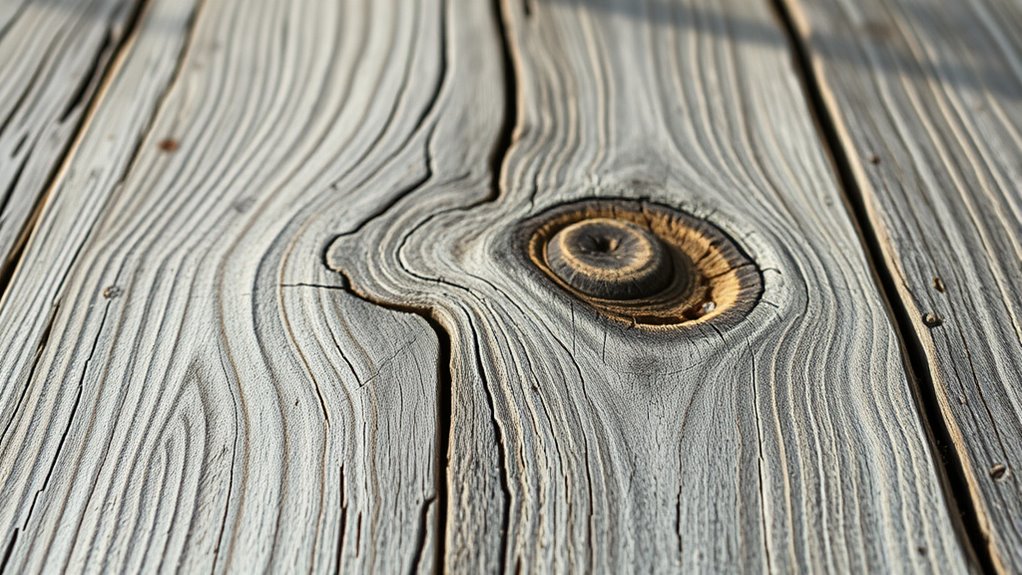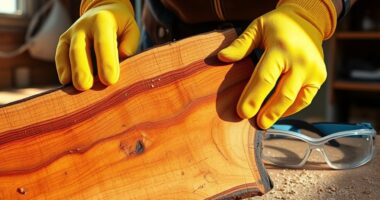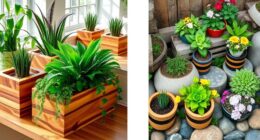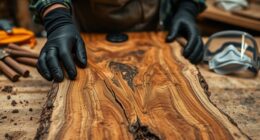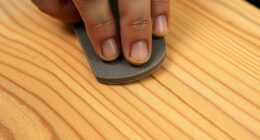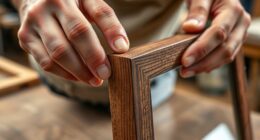Working with reclaimed barnwood is a rewarding way to add rustic charm while staying environmentally conscious. Start by inspecting each piece for stability, then clean and lightly sand to bring out its natural texture and character. Plan your cuts carefully to minimize waste and handle with care to prevent warping or splitting. Remember, patience and attention to detail are key to achieving beautiful results. Keep exploring, and you’ll discover more tips to safely work with this unique material.
Key Takeaways
- Inspect each piece carefully for stability, warping, or damage before starting your project.
- Clean and lightly sand barnwood to reveal its natural texture and enhance its appearance.
- Plan your cuts and measurements precisely to maximize material use and avoid waste.
- Use gentle cleaning methods and appropriate finishes to preserve the wood’s authentic patina.
- Handle with care, wear protective gear, and take your time to ensure a successful, lasting project.
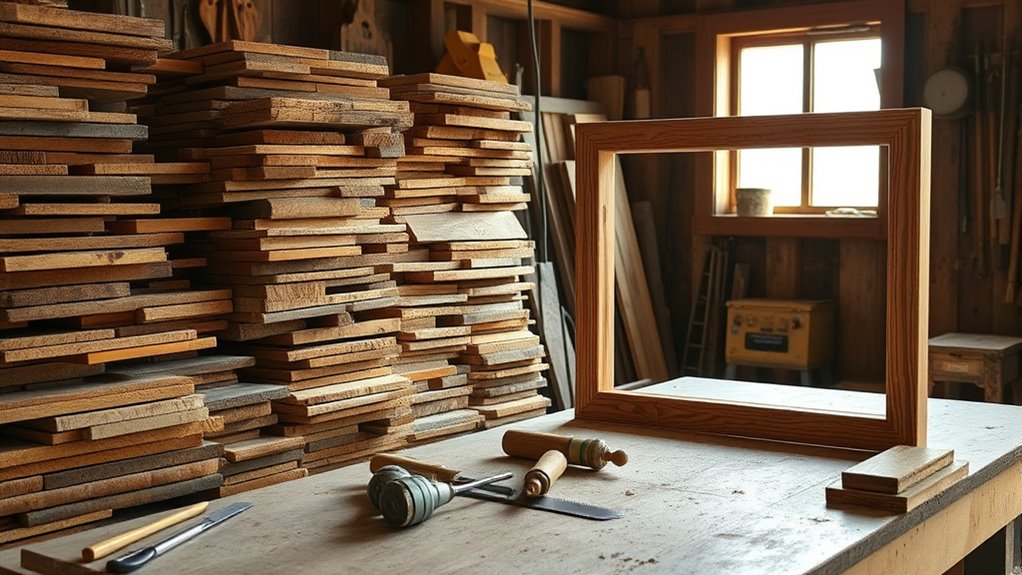
Are you curious about how reclaimed barnwood can transform your space? If so, you’re in the right place. Reclaimed barnwood offers a unique way to add character and charm to your home or project, while also supporting sustainable sourcing. By choosing barnwood that’s been salvaged from old barns, you’re helping reduce waste and minimize the environmental impact of new lumber production. This eco-friendly approach not only benefits the planet but also ensures that your materials have a rich history and authentic texture that new wood simply can’t replicate. The antique aesthetics of reclaimed barnwood bring a timeless appeal to any design, creating a warm, inviting atmosphere that feels both rustic and refined.
When working with reclaimed barnwood, it’s essential to understand its unique qualities. Unlike fresh lumber, barnwood has often been exposed to decades of weather, which gives it a distinctive look—weathered, textured, and full of character. These imperfections, such as knots, nail holes, and grain variations, aren’t flaws but features that highlight its history. To get the most out of your project, inspect each piece for stability and integrity before using it. Sometimes, reclaimed wood needs a bit of cleaning or light sanding to reveal its beauty and prepare it for finishing. Keep in mind that barnwood can be more prone to warping or splitting if not handled properly, so proper installation and treatment are key. Additionally, understanding the weathered surface and how it affects finishing options can help ensure a durable and attractive result.
Choosing reclaimed barnwood also means embracing its antique aesthetics. Its aged patina, subtle color variations, and natural distressing add a layer of authenticity that new materials often lack. This makes it perfect for creating focal points, accent walls, or custom furniture that tells a story. To preserve its character, consider using gentle cleaning methods—avoid harsh chemicals—and opt for finishes that enhance the wood’s natural beauty without obscuring its history. Because each piece of barnwood is unique, you’ll find that no two projects turn out exactly the same, giving your space its own personal touch.
Finally, working with reclaimed barnwood requires patience and an eye for detail. Measure carefully, plan your cuts to maximize the use of each piece, and always wear protective gear when cutting or sanding. With a little effort, you’ll create a stunning, environmentally responsible space that celebrates the beauty of the past while making a statement in the present. Reclaimed barnwood isn’t just a material; it’s a conversation piece that combines sustainability with timeless style.
Frequently Asked Questions
How Do I Identify Authentic Reclaimed Barnwood?
To identify authentic reclaimed barnwood, look closely at the wood grain, which should show signs of age like irregular patterns and weathering. Notice color variation; genuine barnwood often has a mix of faded, rustic hues from years of exposure. Avoid new-looking wood with uniform color and grain. Authentic reclaimed wood will also have nail holes, knots, and a weathered texture, confirming its history and uniqueness.
What Safety Precautions Are Necessary When Handling Barnwood?
It’s no coincidence that safety should be your top priority when handling barnwood. You need to wear personal protective equipment like gloves, goggles, and a dust mask to prevent injuries and inhaling harmful particles. Always follow proper handling techniques, lifting with your legs and avoiding sharp edges, to stay safe. Staying cautious guarantees your project stays enjoyable and injury-free, letting you focus on transforming reclaimed barnwood into something beautiful.
Can Reclaimed Barnwood Be Used Outdoors Reliably?
Reclaimed barnwood can be used outdoors, but its weather resistance depends on how well it’s been treated. To guarantee durability, you should seal the wood with a weatherproof finish and regularly maintain it by reapplying protective coatings. Keep in mind, some barnwood may have natural weather resistance, but consistent maintenance tips like cleaning and sealing will prolong its lifespan outdoors. Proper care ensures your reclaimed barnwood stays beautiful and functional.
How Do I Treat Barnwood for Pests or Mold?
To treat barnwood for pests or mold, you should start with proper wood preservation techniques. First, inspect the wood thoroughly for signs of pests or mold. Use a combination of pest control methods, such as applying borate solutions, which also help prevent mold growth. Guarantee good ventilation and keep the wood dry. Regularly check for new issues and reapply treatments as needed to maintain the wood’s integrity and safety.
What Are the Environmental Benefits of Using Reclaimed Barnwood?
Using reclaimed barnwood is like giving a forest a second chance to breathe. It benefits the environment by supporting sustainable forestry practices, reducing the demand for new timber. When you choose reclaimed wood, you cut down your carbon footprint, helping fight climate change. This eco-friendly choice preserves natural resources, minimizes waste, and celebrates history, turning old wood into beautiful, sustainable projects that are better for the planet and future generations.
Conclusion
Now that you’ve mastered the art of working with reclaimed barnwood, go forth and impress everyone with your rustic masterpieces. Who knew salvaged wood could turn you into a barnyard Picasso? Just remember, every splinter is a tiny badge of honor, and if things get a little knotty, you’re doing it right. So embrace the imperfections, channel your inner lumber whisperer, and soon you’ll have a stunning piece that screams “I salvaged this myself!”
